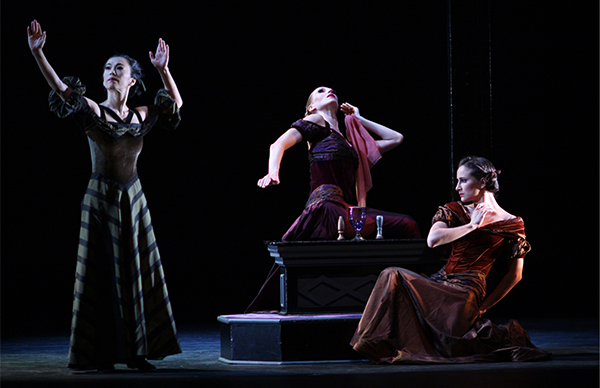Deaths and Entrances was previewed at Bennington College in the summer of 1943 and premiered in New York in December of that year. The country was at war, and Graham was grappling with questions of faith and despair. In a letter to David Zellmer, a Company member serving in the Air Force at the time, she wrote, “There are so many little deaths, those moments of doubt, loneliness, fear . . . moments when one ceases to be for a short time. Then there is the entrance again into the real world of energy that is the source of life, that is the immortality.” Graham was obsessed with her new work. She had been through a year of change, and of fear, afraid that her creative impulses were dried up, “that the wild thing was gone out of her heart,” as she put it.
Set to a score by Hunter Johnson, with sets and lighting by Arch Lauterer, Deaths and Entrances was inspired by the lives of the three Brontë sisters (originally Sophie Maslow, Jane Dudley and Graham herself) and the struggle of women to follow their deepest impulses in the face of convention and tradition. “The dancing is some of the most articulate and significant I have done,” she wrote Zellmer. Audiences, however, found the work mysterious. “The public seems baffled,” Graham observed, “but moved in some way they do not understand.” In the New York Times John Martin wrote “at first seeing it is perfectly safe to say that not a single spectator can honestly report that he knows what the work is all about, though he must acknowledge that it is gripping and emotionally moving.” Objects in the dance have mysterious resonance; a shell, a goblet, a vase, inspire memories of past experience and create a stage for the sisters to revisit childhood memories, imagined lovers. The dance follows its own subconscious logic. Questioned about why she choreographed a sequence of falls while dressed in evening clothes, Graham posed her own question. “Haven’t you ever been in a room where someone you loved, who no longer loved you, walked in, and your heart fell to the floor?”
The brooding, restless quality of the work, and its concerns with the female experience continue to move audiences, “slipping in through the sensory perceptions without ever touching on the accustomed areas on intellection,” as Martin observed long ago.

